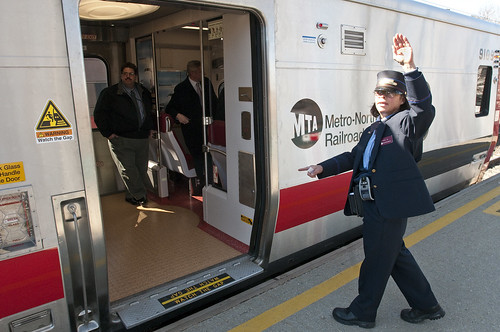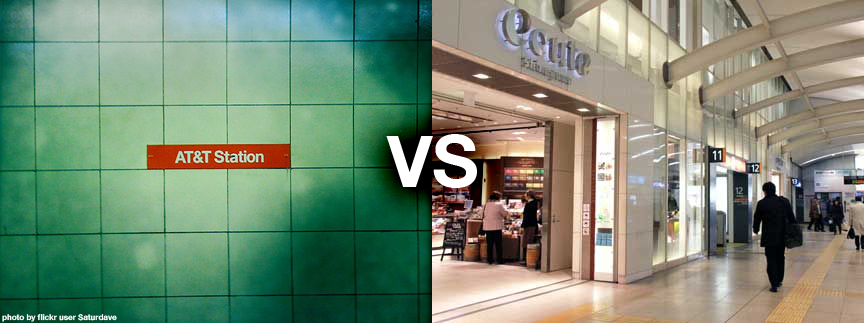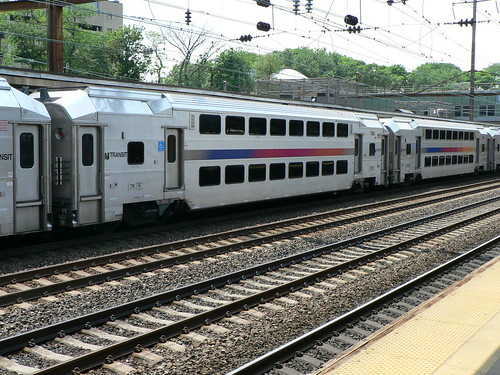
What's In a Name? MBTA Sells Out Boston In Its Naming Rights Plan
The question is on the table again as the MBTA moves forward with its interest in selling naming rights as IMG Worldwide as been announced as the firm that will conduct a 'a thorough analysis to determine if there's a market for naming rights and what the value would be', according to Joe Pesaturo of the MBTA.
Boston is not unique in its operating budget issues, nor is it unique in some of its attempts to close the funding gap. About a year ago, Boston joined New York, Chicago, Philadelphia, Austin, Toronto, and New Jersey in the growing list of North American transit agencies trying desperately to close operating gaps with a funding concept that is an illusion and hardly effective for actually raising the revenues that agencies claim.
To bring it home, one of my followers on Twitter brought to my attention a sponsorship from 1997 to 2000 by Citizens Bank to rename State on the Blue and Orange Lines to State/Citizens Bank. The sponsorship eventually failed and the station's name was reverted.
Ben Kabak in New York has written numerous posts on the issue (in the numerous links above), so I won't bother rehashing a topic. I will however highlight one particular public-private partnership that Chicago capitalised on, which was the $4 million rehab of the North/Claybourn station, all paid for by Apple. If we're going to be selling the system to private entities, why not work with them to refurbish the system or even build out revenue-generating properties without selling the property or rights to profits (Chicago lost $11 billion from a poor leasing agreement of its parking meters to Morgan Stanley)?
While we shouldn't necessarily be relying on commercial entities to be paying for and completely refurbishing our public infrastructure just so they can use them as their own vehicles for advertising, public transport is in an ailing state. Budgets are tight and will continue to get tighter until the costs (of construction and maintenance) are reined in and publicly owned property can be made more profitable.
Of the latter, these public-private partnerships could be used to capitalise on unproductive, low revenue-generating properties owned by the state, such as station head houses, rights of way, and station platforms themselves. Looking at just Porter Square, why is the Shaw's located so far away from the public transport hub that likely brings in the majority of its business from commuters picking up their groceries on their commutes home? Why is there not a passage under Somerville Ave to connect to a basement level of CVS or another business and provide a safer crossing of the major boulevard? This is the ultimate form of not only transit-oriented development, but also leveraging MBTA property as convenient and profitable real-estate to developers. We may be far from Japan's platform-side malls and ramen shops, but it's high time the MBTA start pushing its property and really engaging with developers and private entities to serve the public more directly.
I'd rather be able to grab a fresh bowl of ramen and groceries conveniently on my commute home than ride through Apple/Copley Square or Macy's/Downtown Crossing, especially if I know that one initiative is more likely to keep the trains running, the lights on, and the buses well-maintained.
MBTA Steps Up Its Game, Shares (In)Visible Results
 This morning, the General Manager's twitter account pointed riders to an album of photos on Flickr covering the painting that happened at the Davis Square station this weekend. They also added a few photos of the continued work on the spot repairs they have been doing to the floating slabs along the Red Line, the primary project causing the ongoing weekend service outages of the Red Line north of Harvard.
This morning, the General Manager's twitter account pointed riders to an album of photos on Flickr covering the painting that happened at the Davis Square station this weekend. They also added a few photos of the continued work on the spot repairs they have been doing to the floating slabs along the Red Line, the primary project causing the ongoing weekend service outages of the Red Line north of Harvard.
Before Rich Davey was General Manager of the MBTA three years ago, photos of work on the T were few and far between. Months after I started tweeting about the MBTA (prompted by the phenomenal 2009 derailment of the Red Line, which I experienced personally on a train) and in May 2010, shortly after Davey took office, the MBTA created their twitter account to directly address customers in real time.
Davey was able to sporadically update riders with photos covering things like his visit to Korea earlier this year to tour construction of the first cars in the MBTA's new order of bi-level commuter rail cars. This wasn't nearly enough to assure the public of the work that it does and was far less than what the MTA in neighbouring New York City has been doing with Flickr to cover weekend work.
It's good to see the MBTA has ramped up their own behind-the-scenes coverage of work, instead of having to be at the mercy of the press to cover their overnight and weekend work. This is photographic evidence to reassure the riders and general public that work is being done to the system, especially work that is invisible, but important, to riders. Now it's up to the press, blogosphere, and twitterverse to get the word out.
At the same time, does it really matter that there are photos of work if trains are still late and the MBTA is unable to affect perceivable changes to service quality? Most riders will see these photos and immediately ask, 'Why is my Orange Line train delayed?'
Raising Safety, Efficiency, and Platforms
 With this winter's delays on the commuter rail, it's clear that legislators and MBTA and MBCR administrators need to push harder for better infrastructure and the funds with which to furnish it. But let's take a look at an issue that comes up every once in a while. Despite the MBCR's best efforts at preventing boarding and alighting accidents, through policy or physically securing doors, these accidents happen. In the winter, steps that accumulate ice from billowing snow kicked up as the train moves along can be a liability for passenger accidents and hampers boarding and alighting efforts, even increasing boarding times as people take their time to prevent slips and falls.
With this winter's delays on the commuter rail, it's clear that legislators and MBTA and MBCR administrators need to push harder for better infrastructure and the funds with which to furnish it. But let's take a look at an issue that comes up every once in a while. Despite the MBCR's best efforts at preventing boarding and alighting accidents, through policy or physically securing doors, these accidents happen. In the winter, steps that accumulate ice from billowing snow kicked up as the train moves along can be a liability for passenger accidents and hampers boarding and alighting efforts, even increasing boarding times as people take their time to prevent slips and falls.
I'm down on Long Island for a few days and I'm quickly remembering what fast, frequent, and convenient commuter rail service is like. I can take a train from Penn Station to my parents' stop out in Wantagh, over 50km or about the distance from Boston South Station to Worcester, and reliably be there in 1 hour. Trains on my branch run every 30 minutes to every hour, depending on time of day. This is not only because the electric M-7s the LIRR runs have better acceleration rates than diesel trains, but also because of how passengers can get on and off of the train.
When visiting most any other commuter railroad in first world countries or even our neighbouring commuter railroads to the south, the contrast is very clear. Passengers board and exit at any door along the length of the train from automated doorways that sense obstructions and prevent the train from moving if any of them are open. This is how heavy rail transit, like the Red, Orange, or Blue lines, operate (except when rollingstock on rapid transit is also so old that door sensors don't sense when people or objects are caught).
The top two commuter railroads, Metro North and Long Island Railroads, only have high-level platforms like those pictured above. On the MBTA network, very few stations have full high-level platforms and many have portions that exist only to make the stations ADA-compliant, the construction of which has been furnished by MBTA a multi-year, $1+ billion ADA compliance project.
Even if the Legislature and federal grants furnished the money required for the MBTA to raise its platforms, newer passenger cars (rollingstock) would still need to be purchased in order to fully seize the benefits of high-level boarding. The current and on-order bi-level cars have the latent ability to coordinate closing and opening of doors along the length of the train. Almost none of the older single level cars have this ability; conductors would need to go to every door to open and close them, otherwise lock doors in place to prevent the train from moving with open doors.
Newer commuter rail trains also benefit from the flexibility of having doors not located at end vestibules in order to allow passengers to board and alight more quickly since doors are more evenly spaced along the length of the train. New Jersey Transit's bi-level cars have 'quarter-point' doors, which sit over the trucks (the sets of wheels on a train), in addition to the conventional vestibular doors with 'trap doors' that permit low-level boarding. This isn't the most optimal door configuration, even for bi-level cars, but permits greater flexibility for passengers who are boarding or alighting at high-level platforms.
Aside from platform improvements, a capital expense that would likely cost tens of millions to billions to complete, depending on engineering practices and station geometries, there are several changes inside trains that can happen, namely electronic fare payment. The CharlieCard is now three years late in arriving on commuter rail and I quite frequently still see tweets of people thanking the MBTA for not coming to collect their fare on the train.
If you look at the conductor in the lede photo, you'll notice a small grey device on her belt - all Metro North conductors are equipped with one. This is a portable electronic ticketing machine and allows her to process credit and debit cards so passengers can pay for their fare without juggling cash. It is likely these machines can be upgraded to validate fare with RFID cards or future NFC technologies that the MTA is currently exploring with the MBTA and other regional transit operators. With deals and decisions to be made in the coming years, it's likely the MBTA and others are cooling their heels and waiting for a standard to come in before purchasing soon-to-be-outdated portable fare collection equipment. Long Island Railroad was promised these handy devices in about the same time as the MBTA Commuter Rail, but LIRR conductors still don't have them.
When all is said and done, both raising platforms, reconfiguring stations, and procuring portable fare collection devices will cost money, admittedly money no one seems to have, most especially the MBTA. Though, let's remember that these are expenses that fall under the capital budget, which is almost exclusively furnished by MassDOT, state grants, and federal grants from USDOT funding programs and other agencies. Much of these capital expenses can also be covered by investments from the private sector in the form of associated transit improvements to improve the appeal of or as part of transit-oriented developments around commuter rail stations.
These improvements need to happen in order to improve safety and running times of commuter rail trains, which already suffer from conditions not seen anywhere else in the burgeoning metropolitan regions of the Northeast Megaregion.
Note: MBTA Commuter Rail trains do have to make one accommodation that LIRR, Metro North, and most NJ Transit trains don't - MBTA shares many of its tracks with long, slow-moving CSX trains that are also important to Boston's economy. It will take a much greater amount of infrastructure investment to solve that problem, but that isn't to say DMU or EMU operation of MBTA Commuter Rail trains wouldn't improve service.
Categories
- Children (1)
- Diversions (1)
- Olympics (1)
- MAPC (2)
- Red–Blue Connector (2)
- Urban Design (3)
- Bus (4)
- Fares (4)
- Late Night Service (4)
- MBTA ROC (4)
- Silver Line (4)
- Snow (5)
- Blue Line (8)
- Emergency (8)
- Orange Line (8)
- Public Comment (8)
- Maintenance (9)
- Operations (9)
- Signage (9)
- Fare Collection (10)
- Labs (11)
- Safety (11)
- Planning (12)
- Communication (14)
- MBCR (14)
- MassDOT (14)
- Green Line (16)
- History & Culture (16)
- Red Line (18)
- MBTA Bus (21)
- Commuter Rail (24)
- Advocacy (26)
- Capital Construction (28)
- Politics (30)
- Podcast (35)
- News (38)
- Media (40)
- Funding (42)
- Statements (50)
- MBTA (57)



